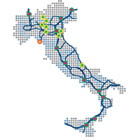
Snam conducts activities regulated by the gas segment and is a significant European operator in terms of regulatory asset base (RAB) in its sector. The group operates in the following areas:

TRANSPORTATION
Natural gas transportation is an integrated service which involves providing transportation capacity and the actual transportation of the gas delivered to Snam Rete Gas to the entry points of the Italian gas transportation network1 up to the redelivery points of the regional network, where the gas is redelivered to the users of the service (users).
The natural gas introduced into the national network originates from imports and, to a lesser extent, national production. The gas from abroad is injected into the national network through seven entry points where the network joins up with the import pipelines (Tarvisio, Gorizia, Gries Pass, Mazara del Vallo, Gela) and the LNG regasification terminals (Panigaglia, Cavarzere).
Snam Rete Gas S.p.A. is the leading Italian natural gas transportation and dispatching operator, and owns almost all the transportation infrastructures in Italy, with over 32,000 kilometres of high- and medium-pressure gas pipelines (approximately 94% of the entire transportation system).
LNG REGASIFICATION
The process for the extraction of natural gas from the fields, its liquefaction for transport by ship and subsequent regasification for use by the users, forms the ‘LNG chain’. The process begins in the country of the exporter, where the natural gas is brought to the liquid state by cooling it to -160° C and subsequently loaded onto tankers for shipping to the destination terminal, the LNG regasification terminal. At the regasification terminal, the LNG is unloaded, then heated and returned to the gaseous state and is input into the natural gas transportation network.
Natural gas is also injected into the National Transportation Network from the LNG terminal at Panigaglia (La Spezia), which is owned by GNL Italia and regasifies 17,500 cubic metres of LNG per day; thus when operating at maximum capacity the terminal can inject over 3.5 billion cubic metres of natural gas into the transportation network annually.
The regasification service includes unloading the LNG from the vessel, operating storage, i.e., the storage time required for vaporising the LNG, regasifying it and injecting it into the national network at the Panigaglia entry point.
STORAGE
The natural gas storage business in Italy is done under a concession regime and it serves to offset the various demands of gas consumption and supply. In fact, procurement has had a basically constant profile throughout the year, while gas demand has been characterised by high seasonal variability with winter demand significantly higher than summer.
Essentially, there are two distinct phases in storage: (i) injection phase, generally concentrated between April and October, consisting of injecting into storage the natural gas deriving from the national transport network; and (ii) the extraction phase, usually concentrated between November and March of the following year, when the natural gas is extracted from the deposit, treated, and redelivered to users by the transportation network.
The storage business is carried out by making use of an integrated whole of infrastructures comprised of deposits, gas treatment plants, compression plants and the operational dispatching system.
Stogit is the major Italian operator and one of the leading European natural gas storage operators, via eight storage fields in Lombardy (four), Emilia Romagna (three) and Abruzzo (one).
NATURAL GAS DISTRIBUTION
The natural gas distribution business operates on a concession regime through the conferral of this service by local public entities; it consists of the service of gas distribution through local transportation networks from delivery points at the metering and reduction stations (city gates) to the gas distribution network redelivery points at the end customers (households, businesses, etc.).
Gas distribution service is carried out for sales companies authorised to market to end customers by the transportation of the gas through city networks.
Italgas undertakes natural gas distribution activities by making use of an integrated system of infrastructures comprised of stations for withdrawing gas from the transport network, pressure reduction plants, local transportation and distribution network, user derivation plants and redelivery points comprised of technical equipment featuring meters at the end customers.
Italgas is the leading Italian operator in the natural gas distribution business in Italy with 1,449 municipal concessions and more than 50,000 kilometres of medium- and low-pressure transportation network.
1 The list of pipelines forming part of the national network and the related definition criteria are reported in the Decree of the Ministry of Industry, Commerce and Trade of 22 December 2000 as amended, based on the provisions of Legislative Decree no. 164 of 23 May 2000 (the ‘Letta Decree’).



